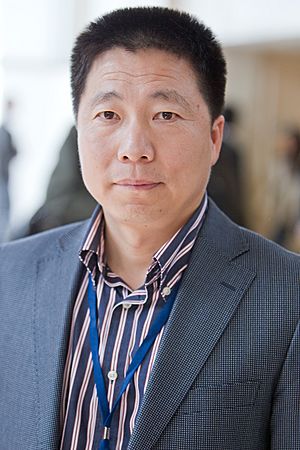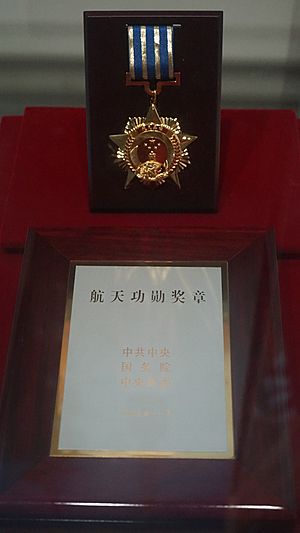Yang Liwei facts for kids
Quick facts for kids
Yang Liwei
|
|
|---|---|

Yang in September 2011
|
|
| Born | 21 June 1965 Suizhong, Huludao, Liaoning, China
|
| Status | Retired |
| Alma mater | Air Force Aviation University (BEng) Tsinghua University (PhD) |
| Space career | |
| PLAAC astronaut | |
|
Current occupation
|
Vice Chief Designer, China Manned Space Engineering |
|
Previous occupation
|
|
| Rank | Major general |
|
Time in space
|
21 hours, 22 minutes, 45 seconds |
| Selection | Chinese Group 1 |
| Missions | Shenzhou 5 |
Yang Liwei (simplified Chinese: 杨利伟; traditional Chinese: 楊利偉; born 21 June 1965) is a famous Chinese astronaut, also known as a taikonaut. He is a former military pilot and holds the rank of major general in the Chinese army.
In October 2003, Yang Liwei made history. He became the first person sent into space by the Chinese space program. His mission, called Shenzhou 5, was a huge success. It made China only the third country in the world to send humans into space all by itself. Today, he helps design new space missions for China.
Contents
Early Life and Training
Yang Liwei was born in Suizhong County, a place in Liaoning, China. His mother was a teacher, and his father worked as an accountant. Yang Liwei is married to Zhang Yumei, and they have a son. Zhang Yumei also worked for the Chinese army and was a teacher in China's Space Program.
In 1983, Yang Liwei joined the People's Liberation Army (PLA). He went to the Air Force Aviation University, where he studied to become a pilot. He graduated in 1987 with a bachelor's degree. Before he started training for space, he flew fighter jets for 1,350 hours.
Later, in 2004, Yang Liwei went to Tsinghua University in Beijing. He studied for his doctorate degree there. In 2009, he earned a Doctor of Philosophy in Management.
Becoming a Taikonaut
Yang Liwei was chosen to be a taikonaut candidate in 1998. Since then, he trained very hard for space flight. He was one of 14 candidates picked for China's first human space mission. At the time of his mission, he was a Lieutenant Colonel in the air force. He was promoted to a full Colonel shortly after his space journey.
The launch of his spacecraft, Shenzhou 5, happened on 15 October 2003. This date was chosen to fit with important events in China. President Hu Jintao was even there to watch the launch. The launch was not shown live on TV. This was to prevent any bad news if something went wrong.
The Shenzhou 5 Mission
Yang Liwei blasted off into space aboard his Shenzhou 5 spacecraft. It was carried by a Long March 2F rocket. The launch happened from the Jiuquan Satellite Launch Center in the Gobi Desert. This was at 9:00 AM Chinese time on 15 October 2003. Before the launch, most details about the taikonauts were kept secret. Yang's selection was only announced the day before. Two other astronauts, Nie Haisheng and Zhai Zhigang, were also ready as backup.
About two minutes after launch, Yang Liwei felt strong vibrations. He said it was "very uncomfortable." Engineers later found out these vibrations came from the rocket. Because of this, they made changes to the next CZ-2F rocket for the Shenzhou-6 mission.
During his trip, Yang Liwei often said, "I feel good." He even spoke to his wife from space. He told her, "I feel very good, don't worry." He ate special space food like shredded pork and Kung Pao chicken. He also drank Chinese herbal tea. Yang slept twice during his flight, for three hours each time. At one point, TV showed him waving small flags of China and the United Nations inside his capsule.
Chinese media reported that Yang's capsule had a gun, a knife, and a tent. These were for safety in case he landed in an unexpected place.
Landing and Return
Yang's spacecraft landed in the grasslands of Inner Mongolia in China. This happened around 6:30 AM Chinese time on 16 October 2003. He had completed 14 orbits around Earth. He traveled more than 600,000 kilometers. Yang was in space for a total of 21 hours. He left the capsule about 15 minutes after landing. Premier Wen Jiabao was there to congratulate him.
Even though Yang Liwei was the first Chinese citizen in space, he was not the first person of Chinese background to go to space. Shanghai-born Taylor Wang flew on a Space Shuttle mission in 1985. However, Wang had become a United States citizen. Another person born in China, William Anders, was born in Hong Kong in 1933. Anders was part of the Apollo 8 mission to orbit the Moon in 1968.
After his mission, Yang Liwei visited Hong Kong on 31 October 2003. He shared his experiences during a six-day visit. An exhibition there showed his reentry capsule, spacesuit, and even leftover food from his mission. He also visited Macau on 5 November.
On 7 November, Yang received the title of "Space Hero." This honor was given to him by Jiang Zemin, the Chairman of the Chinese military. He also received a special badge. Russia also gave him the Gagarin medal. The Chinese University of Hong Kong gave Yang an honorary doctorate degree. The asteroid 21064 Yangliwei and a fossil bird called Dalingheornis liweii are named after him.
After His Spaceflight
After his successful flight, it was decided that Yang Liwei would not go on future space missions. This was similar to how the Soviet Union treated their space hero, Yuri Gagarin. Yang was promoted to Major General on 22 July 2008.
After the Shenzhou 5 mission, Yang was given an important job. He became the vice-commander-in-chief of the astronaut system for China's human spaceflight project.
In October 2017, the United Nations Educational, Scientific and Cultural Organization (UNESCO) gave Yang the UNESCO Medal on Space Science.
Today, Yang Liwei is the director of the China Manned Space Engineering Office. This means he helps lead China's efforts to send people into space.
See also
 In Spanish: Yang Liwei para niños
In Spanish: Yang Liwei para niños
- List of Chinese astronauts
- Chinese space programme


